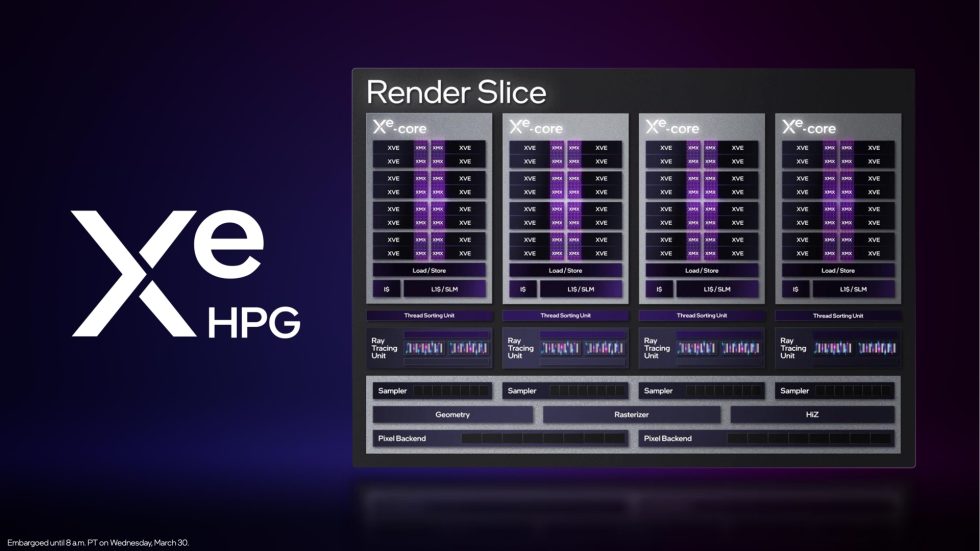

Intel’s long-awaited Arc GPUs begin shipping today, starting in laptops
source link: https://arstechnica.com/gadgets/2022/03/intels-long-awaited-arc-gpus-begin-shipping-today-starting-in-laptops/
Go to the source link to view the article. You can view the picture content, updated content and better typesetting reading experience. If the link is broken, please click the button below to view the snapshot at that time.

the long arc —
Intel’s long-awaited Arc GPUs begin shipping today, starting in laptops
Launch begins with Arc 3, which competes with low-end GeForce and Radeon GPUs.
Andrew Cunningham - 3/30/2022, 3:00 PM

Maybe you've heard about it: After years of rumors and occasional false starts, Intel is leveraging its experience building integrated GPUs to enter the dedicated graphics business. The company's Arc GPUs will be trickling out throughout 2022, and Intel's stated goal is to shake up a market that has been dominated by Nvidia's products (and AMD's, but let's be honest, mainly Nvidia's) for years now.
That process formally begins Wednesday with the launch of the first Arc GPUs for laptops. These Arc mobile GPUs first made an appearance in January when they were obliquely mentioned (with no model numbers, specs, or other technical information) in some of the laptop makers' product announcements. Now that those PCs are closer to shipping, Intel is talking a bit more about what you can expect from its first serious effort to produce modern dedicated GPUs.
-
The five Arc GPU models being announced today are based on two chips: the low-end ACM-G11 and the high-end ACM-G10.
-
The Arc A370M is a fully enabled ACM-G11 die, while the A770M is a fully enabled ACM-G10 die. All the other products use the same dies with lower clock speeds, narrower memory buses, and fewer cores.
The Arc mobile GPUs' branding mirrors the division between Intel's Core i3, i5, and i7 processors; the company is launching a pair of Arc 3 GPUs now, and one Arc 5 and two Arc 7 models will be coming in the "early summer." These five products are based on two different dies. The lower-end die, the ACM-G11, is the basis for the two Arc 3 GPUs, while the Arc 5 and Arc 7 are based on the larger ACM-G10.

As we covered last year, the basic building block of each Arc GPU is the "Xe core," each of which combines 16 vector engines, 16 matrix engines, L1 cache, and some other elements. Four Xe cores combine with dedicated ray tracing units and other fixed-function hardware to form a "render slice," and each Arc GPU is built by stacking a bunch of render slices on top of each other. The fully enabled version of ACM-G11 uses two render slices, while a fully enabled ACM-G10 uses eight.
Advertisement
The Arc 3 is clearly being positioned as a competitor to low-end dedicated laptop GPUs like Nvidia's GeForce MX 550 and MX 570, which also use a 64-bit memory bus and similar power budgets (between 25 and 45 W). It will also likely end up competing with the Radeon 660M and 680M GPUs included in Ryzen 6000 series APUs, which are technically integrated graphics sharing system memory but benefit from DDR5 support and the RDNA2 GPU architecture.
-
The Arc A370M provides a decent step up from integrated Iris Xe graphics, though Intel has chosen to highlight games that are playable on either.
-
For games with lower requirements, frame rates above 60 fps are possible even with A370M.
Intel's performance comparisons cut these competing GPUs out of the picture, though, opting instead to focus on how the Arc A370M GPU stacks up against an Iris Xe integrated GPU.
Though Intel's charts don't provide actual numbers for the Iris Xe, they mostly show 1080p gameplay for slightly older games like Doom Eternal or Destiny 2 that perform in the 30 to 40 fps range at medium or high settings on Iris Xe but break 60 fps on the Arc A370M. For lighter competitive games like Fortnite and Valorant, 1080p gameplay above 90 fps is possible on the A370M at high or medium settings.
The size of the boost you'll see is heavily dependent on the game; frame rates at least double for Doom Eternal or Fortnite, while Final Fantasy XIV and Rocket League improve by a much smaller margin. As with its CPUs, Intel will also allow laptop makers to use different TDP figures for each of its GPUs, so an A370M in one laptop may perform a bit differently from the same A370M in a laptop with a larger heatsink and fan. We can also assume that the gap between the Iris Xe GPU and the Arc A350M GPU will be even smaller since the A350M has two fewer Xe cores and a considerably lower clock speed.
All of the games Intel is highlighting are playable on integrated graphics at 1080p in the first place (using a 30 fps average as our threshold for "playable"), and we don't know how more demanding games like Cyberpunk 2077 or Microsoft Flight Simulator 2020 will run on the A370M. But it's clear that the Arc 3 GPUs are being positioned as a step up from integrated graphics for midrange laptops, not a solution meant to power a dedicated gaming rig.
Page:
Recommend
About Joyk
Aggregate valuable and interesting links.
Joyk means Joy of geeK
